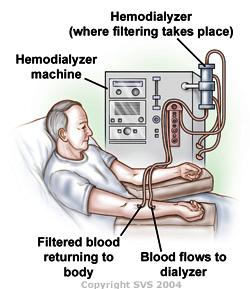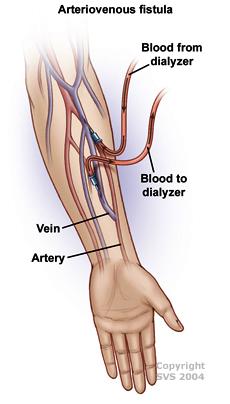If your kidneys fail, unless and until you have a successful kidney transplant, you will need dialysis therapy to clean and filter your blood. The first step is establishing dialysis access one of four ways:
A tunneled catheter in your neck—temporary, because the possibility of infection is high.
An AV fistula—taking a piece of a vein from your arm or leg and sewing it into a nearby artery, and allowing the sewn-in vein to enlarge and become thicker, like an artery. Considered the best option because it has the lowest risk of infection.
An AV graft—the sewing of a prosthetic graft between an artery and vein in your arm or leg. The preferred option if your veins are too small for an AV fistula. AV grafts tend to close more quickly and are more prone to infection because they are not formed from natural tissue.
Peritoneal dialysis—placement of a small tube, called a cannula, in your abdomen to allow the use of the lining of the abdomen (peritoneum) to filter your blood. It requires several “exchanges” every day: you introduce and remove fluid through the tube. A convenient option because you perform the dialysis therapy at home, but infections sometimes occur and the tube can become clogged.
When your kidneys fail, your body is unable to clean and filter your blood. Electrolyte levels, such as potassium and phosphorous, can become dangerously high. When kidney function falls below a certain threshold dialysis is needed.
If it appears that dialysis will be needed in the future, it’s time to establish dialysis access, ideally with one of the three permanent methods described above (option 2, 3 or 4).
Here are the steps for creating an AV fistula or AV graft (the most common procedures), usually involving your non-dominant arm:
Assessment
- Your dialysis access surgeon will explain the procedure and perform a physical exam, focusing on the arm or leg selected.
- Usually, an ultrasound scan is used to “map” your veins to see if they are large enough for an AV fistula. If not, an AV graft will be needed.
Anesthesia
A variety of anesthesia techniques can be used:
- Local anesthesia—numbing medication given by injection at the fistula or graft site, often along with sedation medication given through an IV.
- A regional block—numbing the nerves so that your entire arm or leg “sleeps.”
- General anesthesia—usually involves sedation medication given through an IV, sometimes along with gas that you breathe from a mask, and often includes placing a tube into your throat to make sure you breathe properly.
Procedure
- In the operating room, your arm or leg is cleansed with an antiseptic solution and sterile drapes are placed around it.
- An incision is made between the artery and vein, and the vessels to be joined are prepared.
- If creating a fistula, your surgeon may divide the vein and sew one end to the side of the artery, or may sew the two vessels side-to-side without dividing the vein.
- If a graft will be placed, your surgeon will sew it between the artery and vein.
- The incision in your arm or leg will be closed and a sterile dressing will be applied.


Bleeding is the most common complication. Generally, this is noticed and taken care of before you go home.
Contact Your Dialysis Access Surgeon Immediately If...
- You notice swelling or a saturated dressing.
- Your hand or leg becomes very cold or numb as this may indicate a serious problem (“steal syndrome”) that may need urgent attention.
Slight coolness in the affected hand or leg is common. This happens because some of the blood that was supplying the hand or leg is being redirected. Squeezing an old tennis ball or racquetball in your hand can help your body re-adjust.
Vibration changes or pulsation When you place your hand over the fistula or graft, you should feel a vibration. If the vibration stops or becomes a pulsation, contact your dialysis access surgeon as the change may indicate that the access has narrowed.
You will be asked to avoid having blood drawn from veins in the selected arm or leg. This is sometimes referred to as “preserving the veins.”
Fast (no food or drink) for 8 hours prior to the procedure, unless your operating team directs otherwise.
At the hospital, you may be asked to wear a “no IV access” band on the unaffected arm or leg.
- The vein will enlarge and it should be easy to feel a vibration.
- Avoid sleeping on the affected arm or leg
- Avoid constrictive clothing over the site.
- Most surgeons recommend a healing period before your first dialysis treatment.
- 2-3 months for a fistula.
- At least 4 weeks for a graft.
- Once you begin dialysis, inspect the access site regularly for bleeding or signs of infection, such as redness or warmth.
